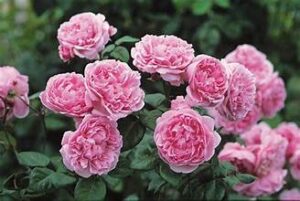### Economic Analysis of the Pompadour Rose Market: Supply and Demand

The Pompadour Rose, renowned for its exquisite beauty and rich symbolism, is not only a beloved flower but also a significant commodity in the global floral market. This analysis examines the economic dynamics of the Pompadour Rose market, focusing on the factors that influence its supply and demand. By exploring production practices, market trends, and consumer behavior, we can gain a comprehensive understanding of how the Pompadour Rose operates within the broader economic landscape.
#### Supply Side Analysis
Understanding the supply side of the Pompadour Rose market involves examining the various factors that affect production, including cultivation practices, geographic distribution, and production costs.
1. **Cultivation Practices and Geographic Distribution**
– The cultivation of Pompadour Roses requires specific climatic conditions, with temperate regions being the most suitable for their growth. Major producers include countries such as the Netherlands, Colombia, Kenya, and Ecuador, where the climate supports year-round production. Each of these regions has developed advanced horticultural practices to optimize yield and quality.
– In the Netherlands, for instance, the use of advanced greenhouse technology allows for precise control over growing conditions, leading to high-quality blooms. Colombia and Ecuador benefit from their equatorial climates, which provide consistent sunlight and stable temperatures, ideal for rose cultivation. Kenya, with its high-altitude regions, offers a conducive environment for growing robust roses with vibrant colors.
2. **Production Costs**
– The cost of producing Pompadour Roses includes several components: labor, inputs (such as fertilizers and pesticides), infrastructure (greenhouses and irrigation systems), and energy costs. In regions like Kenya and Ethiopia, lower labor costs provide a competitive advantage, allowing these countries to supply large volumes of roses to the global market at relatively lower prices.
– However, high-quality Pompadour Roses, especially those produced in technologically advanced facilities like those in the Netherlands, tend to have higher production costs. These costs are justified by the superior quality of the roses, which can command higher prices in the market.
3. **Seasonality and Production Cycles**
– Although roses can be cultivated year-round, certain periods see higher production due to optimal growing conditions. This seasonality can impact supply levels and prices. For example, during the peak growing seasons in equatorial countries, the market may experience an influx of roses, potentially driving down prices. Conversely, during off-peak seasons, supply constraints can lead to higher prices.
4. **Technological Advancements**
– Innovations in agricultural technology play a significant role in increasing the supply of Pompadour Roses. Developments in greenhouse technology, hydroponics, and pest control methods have enabled growers to increase yield, improve quality, and reduce production costs. These advancements have also allowed producers in less traditional growing regions to enter the market, thereby expanding global supply.
#### Demand Side Analysis
The demand for Pompadour Roses is influenced by a variety of factors including consumer preferences, cultural significance, and economic conditions.
1. **Consumer Preferences and Trends**
– The appeal of the Pompadour Rose is largely driven by its aesthetic qualities and the cultural significance it holds in various societies. In many cultures, roses are symbols of love, beauty, and elegance, making them a popular choice for special occasions such as weddings, anniversaries, and Valentine’s Day.
– Trends in floral design and fashion also impact demand. For example, a rising trend in the use of luxurious and rare flowers in wedding bouquets and high-end events has boosted the demand for premium varieties like the Pompadour Rose. Additionally, the increasing popularity of personalized and artisanal floral arrangements has led to a greater appreciation for unique and high-quality roses.
2. **Cultural Significance**
– The symbolic meanings attributed to the Pompadour Rose vary across cultures, contributing to its demand in different regions. In Japan, for instance, the Pompadour Rose is not only a popular gift but also an important element in traditional ceremonies and festivals, driving consistent demand.
– In Western cultures, the Pompadour Rose is often associated with romantic love and luxury, making it a staple in the floral industry. The cultural importance of roses in expressions of love and affection ensures a steady demand throughout the year, with peaks around specific holidays and events.
3. **Economic Conditions**
– The overall economic environment significantly affects consumer spending on luxury goods, including high-end flowers like the Pompadour Rose. During periods of economic prosperity, consumers are more likely to spend on premium flowers for events and personal enjoyment. Conversely, economic downturns can lead to reduced spending on non-essential items, impacting the demand for luxury roses.
– However, even during economic downturns, the demand for roses may remain relatively stable for certain key occasions, as they are considered essential for expressions of emotion and celebration.
4. **Marketing and Distribution Channels**
– Effective marketing strategies and the availability of diverse distribution channels play a crucial role in shaping demand. Online flower delivery services have expanded access to Pompadour Roses, making it easier for consumers to purchase them for various occasions. Social media platforms and e-commerce websites have also played a significant role in promoting the aesthetic appeal of these roses, reaching a wider audience and boosting demand.
– Traditional brick-and-mortar florists continue to play an important role, particularly for customers who prefer to see and select flowers in person. Collaborations between growers, wholesalers, and retailers ensure that Pompadour Roses are available in both physical and online stores, catering to different consumer preferences.
#### Price Determination and Market Equilibrium
The interaction between supply and demand in the Pompadour Rose market determines the equilibrium price. This section explores how various factors influence prices and market equilibrium.
1. **Price Elasticity of Demand**
– The demand for Pompadour Roses is generally price elastic, meaning that changes in price can significantly affect the quantity demanded. Luxury flowers like the Pompadour Rose are often considered discretionary items, so significant price increases may lead to a noticeable drop in demand, particularly among price-sensitive consumers.
– Conversely, during peak seasons and special occasions, demand becomes more inelastic as consumers are willing to pay higher prices for high-quality roses. The emotional and cultural significance of roses during these times makes consumers less sensitive to price changes.
2. **Impact of Supply Fluctuations**
– Supply fluctuations due to seasonality, weather conditions, or production challenges can lead to price volatility. For instance, adverse weather conditions in major growing regions can reduce supply, leading to higher prices. Similarly, technological advancements that increase production efficiency can boost supply, potentially lowering prices if demand remains constant.
– Producers and distributors often use strategies such as advance contracts and inventory management to mitigate the impact of supply fluctuations. These measures help stabilize prices and ensure a steady supply of Pompadour Roses in the market.
3. **Market Equilibrium and Price Trends**
– The equilibrium price of Pompadour Roses is achieved when the quantity supplied matches the quantity demanded. However, this equilibrium is dynamic and can shift due to changes in either supply or demand. For example, an increase in consumer preference for luxury flowers can shift the demand curve to the right, leading to higher equilibrium prices if supply does not increase correspondingly.
– Historical price trends indicate that the prices of Pompadour Roses generally rise during peak demand periods such as Valentine’s Day and weddings season, and decrease during off-peak periods. Long-term trends are also influenced by broader economic conditions, technological advancements, and changes in consumer preferences.
#### Global Trade and Market Dynamics
The global trade of Pompadour Roses involves complex interactions between various market players, including producers, exporters, importers, and retailers. Understanding these dynamics is crucial for analyzing the overall market.
1. **Major Exporting and Importing Countries**
– The leading exporters of Pompadour Roses include the Netherlands, Colombia, Kenya, and Ecuador. These countries leverage their favorable growing conditions and advanced horticultural practices to supply roses to global markets.
– Major importing countries include the United States, Germany, the United Kingdom, and Japan. These countries have high demand for luxury flowers, driven by cultural practices and consumer preferences for premium floral products.
2. **Trade Regulations and Tariffs**
– International trade of Pompadour Roses is subject to various regulations and tariffs, which can impact prices and market access. Trade agreements between countries can facilitate smoother transactions and reduce costs, while restrictive tariffs and regulations can pose challenges for exporters and importers.
– Quality standards and phytosanitary regulations also play a crucial role in the trade of roses. Exporters must ensure that their products meet the stringent quality and safety standards of importing countries to avoid rejections and penalties.
3. **Logistics and Supply Chain Management**
– The logistics of transporting Pompadour Roses from growers to consumers involves careful supply chain management to maintain the quality and freshness of the flowers. This includes cold chain logistics, efficient transportation networks, and timely delivery services.
– Innovations in packaging and preservation techniques have enhanced the ability to transport roses over long distances without compromising their quality. These advancements are particularly important for maintaining the high standards expected by consumers in premium markets.
4. **Market Competition and Pricing Strategies**
– The Pompadour Rose market is highly competitive, with numerous players vying for market share. Producers and retailers employ various pricing strategies to attract customers and maximize profits. For example, some may focus on high-volume, lower-cost production, while others may emphasize premium quality and exclusivity.
– Marketing and branding efforts also play a critical role in differentiating products and creating a competitive edge. Companies that successfully build strong brands and establish a reputation for quality can command higher prices and foster customer loyalty.
#### Conclusion
The economic analysis of the Pompadour Rose market reveals a complex interplay between supply and demand factors that shape the production, pricing, and consumption of this luxurious flower. From cultivation practices and production costs to consumer preferences and market trends, various elements contribute to the dynamic nature of the Pompadour Rose market.
### Economic Analysis of the Pompadour Rose Market: Supply and Demand (Part 2)
Continuing our exploration of the economic dynamics of the Pompadour Rose market, we delve deeper into the intricate balance between supply and demand factors that shape this flourishing industry. Particular attention is paid to market trends, pricing mechanisms, and the global trade landscape, offering insights into the complexities of this coveted commodity.
#### Market Trends and Consumer Behavior
Market trends and consumer behavior play a pivotal role in shaping the dynamics of the Pompadour Rose market, influencing both supply and demand factors.
1. **Consumer Preferences and Product Differentiation**
– Consumer preferences for specific rose varieties, colors, and quality standards drive producers and retailers to differentiate their offerings. Pompadour Roses, with their unique characteristics and cultural significance, cater to discerning consumers seeking premium floral products.
– Producers may invest in breeding programs to develop new Pompadour Rose varieties with desirable traits such as longer stems, larger blooms, or unique colors. These efforts aim to capture market share by offering exclusive and high-quality products that command premium prices.
2. **Sustainability and Ethical Considerations**
– Growing awareness of environmental and social issues has led to increased demand for sustainably produced Pompadour Roses. Consumers are increasingly concerned about the ecological footprint of floral cultivation practices, prompting producers to adopt eco-friendly and socially responsible methods.
– Certification programs such as Fair Trade and Rainforest Alliance provide assurance to consumers that Pompadour Roses are grown and harvested in an ethical and sustainable manner. These certifications can enhance the marketability of roses and appeal to environmentally conscious consumers.
3. **Digitalization and E-Commerce**
– The proliferation of e-commerce platforms and digital marketing channels has transformed the way Pompadour Roses are bought and sold. Online retailers offer a wide selection of roses, allowing consumers to browse and purchase from the comfort of their homes.
– Digital platforms also facilitate direct communication between producers and consumers, enabling growers to showcase their products and tell their story. Social media platforms, in particular, play a significant role in shaping consumer perceptions and driving purchasing decisions.
#### Pricing Mechanisms and Market Equilibrium
Pricing mechanisms in the Pompadour Rose market are influenced by a combination of supply and demand dynamics, production costs, and market competition.
1. **Price Discrimination and Segmentation**
– Producers and retailers often employ price discrimination strategies to maximize revenue by segmenting the market based on consumer preferences and willingness to pay. Premium quality Pompadour Roses may be sold at higher prices to luxury markets, while standard-grade roses are targeted at more price-sensitive segments.
– Seasonal fluctuations in demand, such as spikes during Valentine’s Day or wedding seasons, present opportunities for price differentiation. During these peak periods, prices may be adjusted to reflect increased demand and scarcity.
2. **Cost-Based Pricing and Profit Margins**
– Cost-based pricing strategies take into account production costs, overhead expenses, and desired profit margins. Producers calculate the total cost per unit of Pompadour Rose and add a markup to determine the selling price.
– However, cost-based pricing may not fully capture the value perceived by consumers, especially in markets where premium quality and brand reputation play significant roles. As such, producers may adjust prices based on perceived value and competitive positioning.
3. **Dynamic Pricing and Market Information**
– Dynamic pricing algorithms use real-time market data and demand forecasts to adjust prices dynamically in response to changing market conditions. Online retailers and digital platforms often employ dynamic pricing to optimize revenue and inventory turnover.
– Market information, including competitor prices, supply levels, and consumer preferences, informs pricing decisions and helps maintain competitiveness in the market. Pricing intelligence tools enable producers and retailers to monitor market trends and adjust strategies accordingly.
#### Global Trade Dynamics and Market Integration
The Pompadour Rose market is characterized by extensive global trade, with production and consumption spanning multiple countries and regions. Understanding the dynamics of global trade is essential for assessing market trends and identifying opportunities for growth.
1. **Trade Patterns and Regional Specialization**
– Global trade in Pompadour Roses is characterized by regional specialization, with certain countries dominating production and export markets. The Netherlands, for example, is renowned for its high-quality cut roses and advanced horticultural techniques, making it a leading exporter to European and international markets.
– Developing countries such as Colombia, Kenya, and Ecuador specialize in large-scale rose production for export, leveraging favorable climatic conditions and lower production costs. These countries have established themselves as key suppliers to major importing markets, including the United States and Europe.
2. **Supply Chain Integration and Logistics**
– The global trade of Pompadour Roses relies on efficient supply chain management and logistics infrastructure to transport fresh flowers from production centers to consumer markets. Cold chain logistics, including refrigerated transport and storage facilities, are crucial for maintaining the quality and freshness of roses during transit.
– Integrated supply chain networks connect growers, wholesalers, distributors, and retailers, facilitating the seamless flow of goods across borders. Collaboration between stakeholders ensures timely delivery and minimizes losses due to spoilage or damage.
3. **Trade Agreements and Regulatory Frameworks**
– Trade agreements and regulatory frameworks govern international trade in Pompadour Roses, impacting market access, tariffs, and customs procedures. Bilateral and multilateral trade agreements aim to facilitate trade by reducing barriers and promoting cooperation between countries.
– Regulatory standards for phytosanitary requirements, packaging, and labeling ensure compliance with import regulations and quality standards. Producers and exporters must adhere to these standards to access international markets and avoid disruptions to trade.
#### Conclusion
The economic analysis of the Pompadour Rose market provides valuable insights into the complex interplay of supply and demand dynamics, pricing mechanisms, and global trade dynamics. From consumer preferences and market trends to pricing strategies and trade integration, various factors shape the production, distribution, and consumption of this cherished floral commodity.
As the Pompadour Rose market continues to evolve in response to changing consumer preferences, technological advancements, and global trade dynamics, stakeholders must adapt their strategies to remain competitive and capitalize on emerging opportunities. By understanding the underlying economic principles driving the market, producers, retailers, and policymakers can make informed decisions that promote sustainable growth and prosperity within the Pompadour Rose industry.


